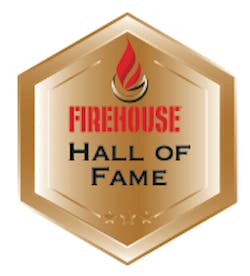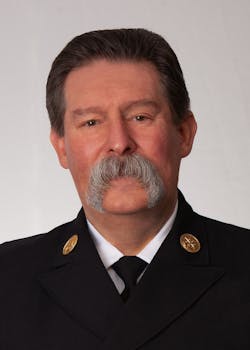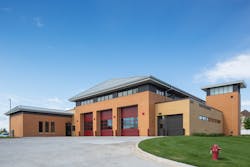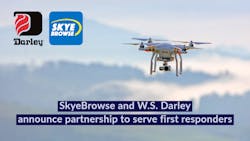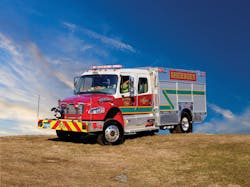Firehouse Announces Newest Hall of Fame Inductees
Steve Austin and J. Curtis Varone were selected as the newest members of the Firehouse Hall of Fame. They will be honored during the Opening Ceremonies at Firehouse Expo at Nashville’s Music City Center.“Steve and Curt have focused on improving their local fire departments and advancing the safety and health of our nation’s fire service throughout their distinguished careers,” Firehouse Editor-in-Chief Peter Matthews says. “Steve has spent more than 40 years improving accreditation for training organizations and instructing on firefighter safety at roadway operations. Curt has provided the fire service with a better understanding of legal issues, including FLSA and liability.”
Austin joined the fire service in 1963 and served as a volunteer firefighter in four states. He served as president of the Delaware Volunteer Firemen’s Association and the Cumberland Valley Volunteer Firemen’s Association and currently serves as the director of external affairs for the International Association of Arson Investigators. Austin is a member of the International Fire Service Training Association Executive Board and of the Board of Directors of the Congressional Fire Services Institute. He is a recipient of the Mason Lankford Fire Service Leadership Award.
In 2008, Varone retired from the Providence Fire Department as a deputy assistant chief and became the director of NFPA’s Public Fire Protection Division. He also became more active with the Exeter, RI, Fire Department, where he now serves as deputy chief. He practices law in Maine and Rhode Island and lectures extensively on legal issues in the fire service. He is the author of Firehouse Magazine’s Fire Law column and runs Fire Law Blog.
For more information on both inductees, visit firehouse.com/21137541.
2020 State of Fire Stations Survey
Firehouse Magazine, in partnership with BKV Group, is conducting the “2020 State of Fire Stations in North America Survey.” The goal of the survey is to determine the current status of fire stations across the United States.
With the ever-changing responsibilities of fire, rescue and EMS departments across the nation, the capability of fire stations to accommodate larger and multipurpose apparatus, increased equipment for various response disciplines, and increased PPE and decontamination procedures continues to trend.All agencies, from metro departments to rural departments, are encouraged to participate in the survey. An update on the “2020 State of Fire Stations in North America Survey” will be presented at the 2020 Station Design Conference, Aug. 10–13, in Rosemont, IL.
After the survey is complete, the findings will be presented in a white paper that will be available to all Firehouse Magazine readers.
“We believe the results of this fire station survey will offer fire chiefs, department officers and municipal leaders a better understanding of fire stations’ capability or limitations to serve the community,” says Janet Wilmoth, who is Firehouse Magazine’s special projects director. “The survey results also will aid in future planning for new or renovated fire stations.”
The Northern Illinois University Center for Government Studies was commissioned to conduct the survey and will tabulate the findings. Craig Carter of BKV Group and Wilmoth worked with the Center for Government Studies to develop the questions to provide content that would be useful to the fire service and local governments.
The questions are focused on the fire station that’s occupied by the officer who completes the survey. We encourage participants to submit a survey for each fire station in your department to obtain a complete understanding of the current stations.
To take the survey, visit firehouse.com/21135894.
Darley, SkyeBrowse Announce Partnership
Custom apparatus builder W.S. Darley entered into a partnership that allows it to provide Skye-Browse 3D modeling software in addition to its UAV offerings to first responders and public safety agencies.
“As more agencies develop UAV programs, there continues to be a growing need for mapping solutions” said Peter Darley, who is chief operating officer of W.S. Darley. “Partnering with SkyeBrowse will allow agencies to rapidly create 3D models utilizing their existing equipment with minimal training. Our team was blown away by the ease of use, low cost and unmatched support of the SkyeBrowse product line, all of which are crucial for the public safety market.”First responders are at high risk from COVID-19 by being at the front lines. SkyeBrowse provides rapid 3D modeling software that allows first responders to make 3D models of scenes within just a few minutes without any prior drone or 3D modeling training. The announcement comes at a time when it already is a top priority for all first responders to spend as little time as possible on scene gathering information.
The SkyeBrowse app is available from the App Store, and licenses will be available for Darley customers starting immediately. Darley also will provide SkyeBrowse licenses along with DJI drones in bundles for various customers.
For more information, visit darley.com.
Rosenbauer to Produce 21 Units for the U.S. Army
Rosenbauer America was awarded a $6 million contract from the U.S. Army National Guard to produce 21 Wildland Type VI units.
These units will be stationed at various U.S. Army National Guard bases throughout the United States to combat wildland fires. All 21 units are scheduled for a 365-day production period and will be delivered in the first quarter of 2021. The apparatus will be equipped with Darley pump modules, 300-gallon water tanks and 30-gallon foam tanks, all configured on an International chassis.“Over the past five years, I have had the privilege of working with various commands in the Army to provide them with state-of-the-art firefighting equipment to enhance their current fleet,” said George Bergamini, who is government sales manager for Rosenbauer America. “With the ever-changing aspects of firefighting, we at Rosenbauer can provide the most advanced technology available in the fire service. We look forward to this project with the Army National Guard protecting those who serve.”
For more information about this project, visit rosenbaueramerica.com.
Line-of-Duty Deaths
13 U.S. firefighters recently died in the line of duty. Eight firefighters died after contracting COVID-19, two died in a motor vehicle accident, two deaths were health-related and one firefighter died following surgery for injuries that were suffered on the job. This issue of Firehouse is dedicated to these firefighters. For the latest on COVID-19-related LODDs, visit firehouse.com/covid-19.
FIREFIGHTER/EMT ISRAEL “IZZY” TOLENTINO, JR., 33, of the Passaic, NJ, Fire Department, died on March 31. On March 14, Tolentino responded with his fire department to an ongoing gas rupture at a residence. All members entered the surrounding structures, including multifamily dwellings and apartments, to check for gas seepage and levels. Three of the residences that Tolentino entered had individuals who had known cases of COVID-19. He subsequently became ill, was diagnosed with COVID-19 and died just over two weeks later.
FIREFIGHTER MARIO ARAUJO, 49, of the Chicago Fire Department, died on April 7. While on official duty on March 1, Araujo contracted the coronavirus from exposure to a patient who had a known case of COVID-19.
CHIEF JAMES “TANK” WATERS, 40, of the Tryon, NC, Fire Department, died on April 7. Waters was assigned to work from his residence because of being quarantined for COVID-19 precautions. While on official duty, he fell ill and suffered a medical emergency. EMS crews responded; they treated and then transported Waters to the hospital, where he was pronounced deceased.
FIREFIGHTER/EMT MICHAEL FIELD, 59, of the Valley Stream, NY, Volunteer Fire Department, died on April 8. On March 24, Field responded to a medical emergency at a residence where a patient had a known case of COVID-19. He subsequently contracted the virus and died two weeks later.
CAPT. FRANKLIN WILLIAMS, 57, of the Detroit Fire Department, died on April 8. On March 22, Williams contracted COVID-19 from working with another firefighter who subsequently tested positive for the virus. Williams died two weeks later.
FIREFIGHTER JOHN SCHOFFSTALL, 41, of the Terre Haute, IN, Fire Department, died on April 12. On March 26, Schoffstall contracted COVID-19 from working with another firefighter who subsequently tested positive for the virus. Schoffstall died just over two weeks later.
SGT. JOHN ANDREW “ANDY” KUCHAR, 43, of the Burlington, KY, Fire Protection District, died on April 16. Kuchar was injured while performing station duties on March 2. He was out of commission for several weeks before undergoing surgery for his injuries. He died at his residence a short time later. The nature and cause of the fatal injury still are to be determined.
FIRE SUPPRESSION TECHNICIAN EDUARDO RAMIREZ, 43, of the El Paso, TX, Fire Department, died on April 21. While performing department-mandated physical fitness training, Ramirez collapsed. He immediately was taken to the hospital, where he died. The cause of his death is under investigation.
LT. HAROLD “EDDIE” MOORE, JR., 42, of the Jackson, ME, Fire Department, died on April 28. Moore responded to a fire. Later, after arriving home, he suffered a cardiac arrest and passed away.
FIREFIGHTER/PARAMEDIC ROBERT DAVID REISINGER, 57, of the River Grove, IL, Fire Department, died on April 29. Reisinger responded to a medical emergency on March 24. The patient had a known case of COVID-19. As a precaution, Reisinger was quarantined at home. On April 27, he suffered a stroke and immediately was taken to the hospital. Upon arrival, hospital staff performed a COVID-19 test, which came back positive. Reisinger died two days later from the COVID-19-related stroke.
CAPT. MIKE TIPOTI, 44, and CAPT. ALLEN VELEGA, 50, of the American Samoa Fire Bureau Division of the Department of Public Safety, died on April 30. After responding to a fire, Tipoti and Velega were returning to the firehouse when their apparatus crashed at a sharp curve after coming down a mountain road. Tipoti, who was driving the apparatus, was pronounced deceased at the scene. Velega was pronounced deceased shortly after his arrival at the hospital emergency room.
DEPUTY FIRE CHIEF EDWARD J. CIOCCA, 62, of the White Plains, NY, Fire Department, died on May 1. While on duty on March 24, Ciocca contracted COVID-19 from working with other firefighters who subsequently tested positive for the virus. He died five weeks later.
About the Author
Firehouse Staff
Content written and created by Firehouse Magazine editors.
